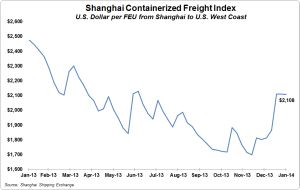Monday, February 17, 2014
Charlotte Delivers
Friday, February 14, 2014
Chinese New Year Impact to Extend Through February
East Coast,
This article is was worth the read.
-
JOC.com • Mike King, Special Correspondent • Feb 12, 2014 10:07PM EST
Air and ocean trades to and from China will remain slow until next month due to the Lunar New Year shutdown, according to a survey by JOC of leading transport operators and analysts based in Asia.
China’s official holiday for New Year ran from Jan. 31 to Feb. 6, but many workers left coastal factories to visit villages in the interior long before then on journeys of three or four days. Few are expected to start returning until next week, after the Lantern Festival.
“Some workers are returning to work, but both air and sea cargo movements are very slow at the moment,” said Byron Lee, managing director of China Global Lines, a Hong Kong forwarding company with a heavy presence in China.
Han Ning, a China-based port consultant with Drewry, said most workers would make their way back to manufacturing factories after the Lantern Festival, meaning many producers will not be operating at full capacity until later in the month. “Factories shut for two weeks before and two weeks after Chinese New Year,” she said. “Port volumes may recover later.”
Paul Tsui, chairman of the Hong Kong Association of Freight Forwarding and Logistics, said even where workers at airport warehouses were in situ, many were simply catching up on administrative matters this week. He does not expect airports to resume normal freight operations until toward the end of the month. “Both air and ocean shall be slow for the whole month of February,” he said
One China-based 3PL executive, who asked not to named, said even when manufacturers do resume output a huge surge in demand for air or ocean is unlikely. “We see no reason for a surge,” he said. “Shipments were planned and rushed out before Chinese New Year.”
The export manager of a major BCO, which supplies a range of industrial equipment produced in factories in China to Europe and the Americas, told JOC that even if his company’s employees were ready to resume production now — which they are not — output would still be dependent on local suppliers of parts and raw materials.
“We can’t resume production until our suppliers are ready,” the U.S. national said. “I try to explain to customers that this means we’ll be shut for a month, but we still get ‘urgent’ orders right through the New Year period.”
“It’s very difficult to explain to customers in Europe and the Americas that there is literally nothing you can do to help them. We try to tell them this will happen every year, but many just don’t understand.”
Container lines have also cut capacity, mostly in the form of blank sailings and missed port calls, in a bid to limit freight rate declines on the major East-West trades.
To the U.S. West Coast, the SCFI was significantly lower compared to a year earlier at $2,108 per FEU on Feb. 7, but week-on-week was holding its ground through the slack season.
The Drewry benchmark rate for shipping from Hong Kong to Los Angeles also remained at $2,086 per 40-foot container for a fourth straight week in the week of Feb. 5, although some analysts forecast declines in the coming weeks.
Members of the Transpacific Stabilization Agreement will be hoping to stand their ground on spot rates prior to planned hikes Asia-U.S. rates of $300 per FEU on March 15 in the run-up to annual contract negotiations. TSA lines are also looking for a further May 1 increase separate from rate adjustments planned for 2014-15 contracts.
Forwarders are, not surprisingly, less upbeat about the possibility of ocean box rates retaining their friction in the coming weeks despite liner capacity cuts. “I would say ocean rates will be unstable for February and March,” Tsui said.
However, he admitted an improvement was “possible” in April.
This article is was worth the read.
-
JOC.com • Mike King, Special Correspondent • Feb 12, 2014 10:07PM EST
Air and ocean trades to and from China will remain slow until next month due to the Lunar New Year shutdown, according to a survey by JOC of leading transport operators and analysts based in Asia.
China’s official holiday for New Year ran from Jan. 31 to Feb. 6, but many workers left coastal factories to visit villages in the interior long before then on journeys of three or four days. Few are expected to start returning until next week, after the Lantern Festival.
“Some workers are returning to work, but both air and sea cargo movements are very slow at the moment,” said Byron Lee, managing director of China Global Lines, a Hong Kong forwarding company with a heavy presence in China.
Han Ning, a China-based port consultant with Drewry, said most workers would make their way back to manufacturing factories after the Lantern Festival, meaning many producers will not be operating at full capacity until later in the month. “Factories shut for two weeks before and two weeks after Chinese New Year,” she said. “Port volumes may recover later.”
Paul Tsui, chairman of the Hong Kong Association of Freight Forwarding and Logistics, said even where workers at airport warehouses were in situ, many were simply catching up on administrative matters this week. He does not expect airports to resume normal freight operations until toward the end of the month. “Both air and ocean shall be slow for the whole month of February,” he said
One China-based 3PL executive, who asked not to named, said even when manufacturers do resume output a huge surge in demand for air or ocean is unlikely. “We see no reason for a surge,” he said. “Shipments were planned and rushed out before Chinese New Year.”
A month-long break
Shippers in China meanwhile report that customers overseas consistently underestimate the impact of Chinese New Year.The export manager of a major BCO, which supplies a range of industrial equipment produced in factories in China to Europe and the Americas, told JOC that even if his company’s employees were ready to resume production now — which they are not — output would still be dependent on local suppliers of parts and raw materials.
“We can’t resume production until our suppliers are ready,” the U.S. national said. “I try to explain to customers that this means we’ll be shut for a month, but we still get ‘urgent’ orders right through the New Year period.”
“It’s very difficult to explain to customers in Europe and the Americas that there is literally nothing you can do to help them. We try to tell them this will happen every year, but many just don’t understand.”
Carriers cut capacity
Airlines move freighter capacity out of China after the pre-Chinese New Year rush, often positioning capacity into flower lanes such as Africa to Europe in the run-up to Valentine’s Day, before redeploying back to Asia when output from China’s export industries resumes.Container lines have also cut capacity, mostly in the form of blank sailings and missed port calls, in a bid to limit freight rate declines on the major East-West trades.
Rates are stable
Spot rates as tracked by the Shanghai Containerized Freight Index were down $13 per TEU at $1,567 per TEU on services to Europe on Feb. 7 compared to a week earlier, but were still close to 12-month peaks.To the U.S. West Coast, the SCFI was significantly lower compared to a year earlier at $2,108 per FEU on Feb. 7, but week-on-week was holding its ground through the slack season.
The Drewry benchmark rate for shipping from Hong Kong to Los Angeles also remained at $2,086 per 40-foot container for a fourth straight week in the week of Feb. 5, although some analysts forecast declines in the coming weeks.
Members of the Transpacific Stabilization Agreement will be hoping to stand their ground on spot rates prior to planned hikes Asia-U.S. rates of $300 per FEU on March 15 in the run-up to annual contract negotiations. TSA lines are also looking for a further May 1 increase separate from rate adjustments planned for 2014-15 contracts.
Forwarders are, not surprisingly, less upbeat about the possibility of ocean box rates retaining their friction in the coming weeks despite liner capacity cuts. “I would say ocean rates will be unstable for February and March,” Tsui said.
However, he admitted an improvement was “possible” in April.
Tuesday, February 4, 2014
Monday, February 3, 2014
Subscribe to:
Posts (Atom)


